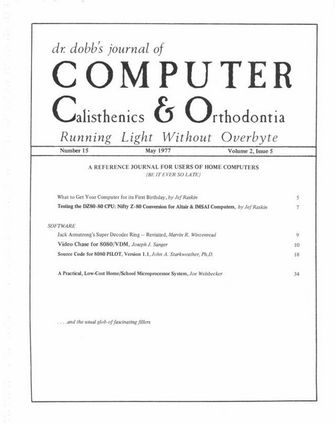
[author : Jef Raskin]
Extract : « Some of you may have missed your computer’s first birthday. If it isn’t too offended you can celebrate its second birthday. Usually a computer shows that its feelings are hurt by not reading cassettes reliably. Here are some under $10 or so items that may put you in good with the CPU.
For $2.95 you can buy a Hexadaisy. This is a mechanical circular slide rule style hexadecimal calculator. I have somewhat mixed feelings about this device, and some colleagues have expressed similar feelings. [...] »
[author : Jef Raskin] #Devices #Review
Extract : « [...] The idea behind the DZ-80 is simple. The Z-80 CPU chip is quite similar to the original 8080, but nothing is for nothing. Along with the new capabilities (such as a duplicate set of registers, and block move instructions, to mention a few) comes the other side of every improvement: incompatibility. You can’t just plug a Z-80 chip in where the 8080 goes. It won’t work. There are a host of differences. Little ones, to be sure, but you would need a small handful of gates to make the Z-80 exactly match the 8080. [...] »
[author : Marvin R. Winzenread] #Listing #BASIC #Cryptography
Extract : « In DDJ Vol. 1, No. 9, Jon O. Stedman presented the Playfaire-Digraphic Cryptographic Cypher. I found the article fascinating and started to write a program that would do the coding and decoding.
The Playfaire method has three deficiencies to my way of thinking. First it requires a knowledge of semantics to decode (e.g. the choice of I or J and X or space). This is easy for a human but difficult for a computer. Second it is not symmetric; coding and decoding are not the same operation when the two characters are in the same row or column. Third it translates only messages and not general text including punctuation symbols and numerals. [...] »
[author : Joseph J. Sanger] #Listing #Assembly #Game
Extract : « There have been many interesting games published to run on personal computers. However, the majority, since they are written in BASIC, assume the existence of a TTY or a TTY- like device; i.e., a display device utilizing a ‘line-at-a-time’ scrolling mode of display. However, many are lucky enough to have memory-mapped video displays - and those who happen to own Processor Technology VDM-1’s in particular will be able to take advantage of this program. [...] »
[author : John A. Starkweather, Ph.D.] #Listing #Assembly #Programming
[author : Joe Weisbecker] #ComputerKit #Electronic #Book
Extract : « My ideas have changed somewhat since I wrote this article. I think such a system could be in the under-$200 range today, but the philosophy is still sound as far as I’m concerned.
EDITOR'S NOTE: Joe was the designer of RCA's COSMAC
Meet Fred
Despite the recreational and educational potential of stored-program computers, the single factor of cost has kept them out of the economic reach of most people. But with the advent of LSI microprocessor and memory chips, this may all change - particularly if we take a more modest applications approach and place reasonable limitations on hardware capability.
Of course, if we need conventional input, output, and bulk storage devices, or if our applications are playing chess, printing pages of data, or accessing large on-line digital/video data bases, the cost will still be prohibitive. However, prototypes of such modest home/school systems have been constructed and in use for several years.
This system, called FRED (Flexible Recreational and Educational Device), has been developed using the RCA COSMAC microprocessor.
A computer of this type could have major social value. As an interactive, open-ended, adaptive, recreational and educational device, it could stimulate the development of analytical and other intellectual abilities. One can easily imagine the formation of a whole new group of computer hobbyists, complete with user groups and publications for the exchange of programs and ideas. In short, the inexpensive home/school computer could open the door to an entirely new environment that stimulates experimentation, analysis, and creativity. [...]
1. J. Weisbecker, “A Simplified Microprocessor Architecture,” Computer (March 1974).
2. N. Swales and J. Weisbecker, “COSMAC - A Microprocessor for Minimum Cost Systems,” 1974 INTERCON, Session 17/2.
3. "Putting Data on an Ordinary Audio Recorder,” The Electronic Engineer (May 1972) p. DC-9.
4. F.. Wolf, “Ratio Recording for LowerCassette Recorder Cost,” Computer Design (December 1972) p. 76.
5. M. Gardner, Logic Machines and Diagrams, McGraw-Hill, 1958.
6. A. Oplcr, “Testing Programming Aptitude,” Datamation (October 1963) pp. 28-31.
7. J. Jones, “The Flap Board: A Simple Diagnostic and Remedial Tool,” Educational Technology (January 1974) pp. 59-61.
8. H. Nurse, “Logidex,” Popular Electronics (November 1973) pp. 63-66.
9. J. L. Hughes and K. J. Engvold, “Hexapawn: A Learning Demonstration,” Datamation (March 1968) pp. 67-73.
10. B. L. Schwartz, “Mathematical Theory of Think-A-Dot,” Mathematics Magazine (September-October 1967) pp. 187-193.
11. R. F. Graf and G. J. Whalen, “Electronic Football Lets You Play Like the Pros,” Popular Mechanics (October 1967) pp. 147-149, 228.
12. J. W. Cuccia, “The Princeps Puzzle,” Popular Electronics (May 1971) pp. 27-32.
13. D. W. Zuckerman and R. E. Horn, The Guide to Simulations / Games for Education and Training, Information Resources, Inc., 1973.
14. M. Gardner, “John Conway’s New Solitaire Game - LIFE,” Scientific American (October 1970), pp. 120-123.
15. D. W. Hagelbarger, “Seer, A Sequence Extrapolating Robot,” IRE Transactions on Electronic Computers (March 1956), pp. 1-7.
16. I. Gilbert and J. Coh, “A Simple Hardware Model of a Turing Machine: Its Educational Use,” Proceedings of the ACM Annual Conference (August 1972) pp. 324-329.
17. J. Ackerman, “Computers Teach Math,” The Arithmetic Teacher (May 1968), pp. 467-468.
18. D. H. Ahl, Ed., 101 Basic Computer Games, Digital Equipment Corp., 1973 »